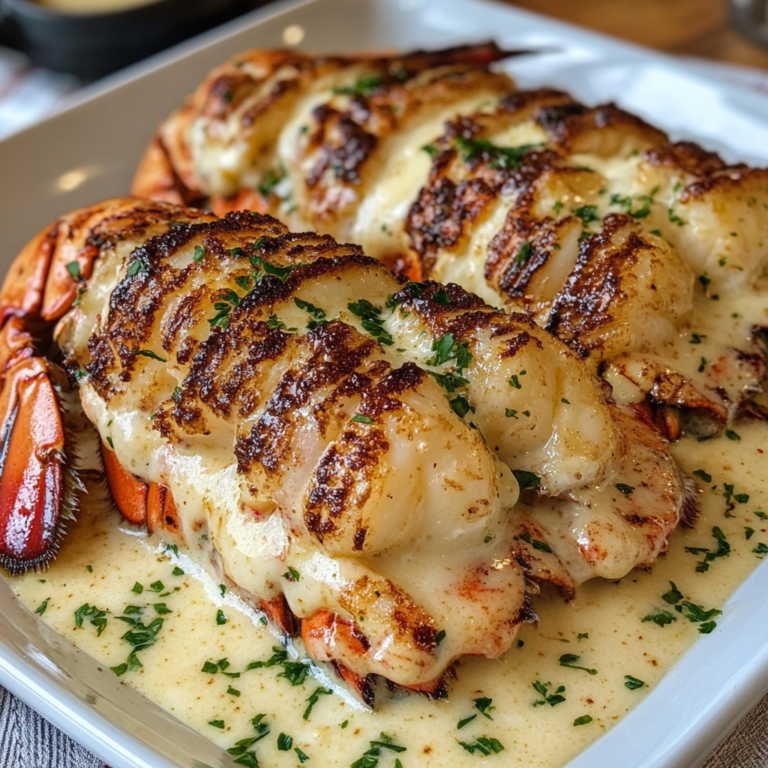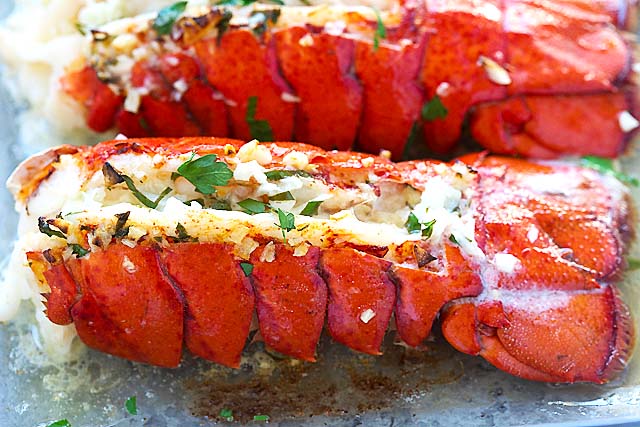A Symphony of Butter and Sea: Mastering the Art of Garlic Butter Lobster Tails

The sizzle of butter, the pungent aroma of garlic, the sweet succulence of lobster – these are the hallmarks of a truly unforgettable culinary experience. Garlic butter lobster tails embody this trifecta perfectly, transforming a simple crustacean into a dish fit for royalty. This isn’t just about throwing some butter and garlic on a lobster; it’s about understanding the nuances of flavor, mastering the technique, and creating a symphony of taste that will leave your guests begging for more.
This comprehensive guide will delve into every aspect of preparing perfect garlic butter lobster tails, from selecting the freshest ingredients to achieving that exquisite balance of richness and garlic punch. We’ll explore various cooking methods, address common pitfalls, and provide tips and tricks to elevate your culinary game to the next level.
I. Selecting Your Star: The Lobster
The quality of your lobster directly impacts the final dish. Choosing the right one is the cornerstone of success. Here’s what to look for:
-
Freshness is Paramount: Opt for live lobsters whenever possible. Their shells should be a vibrant, dark greenish-brown, and they should be active and responsive to touch. Avoid lobsters with dull or discolored shells, a foul odor, or sluggish movement. If buying pre-cooked tails, ensure they are firm and have a bright, pinkish-orange hue. Avoid those that are mushy or discolored.
-
Size Matters: Consider the number of guests and the desired portion size. Larger tails offer more meat, but smaller ones can be easier to manage and cook evenly.

-
Sustainable Sourcing: Be mindful of where your lobster comes from. Choose suppliers committed to sustainable fishing practices to help protect this valuable resource.

II. The Garlic Butter Elixir: A Recipe for Perfection
The garlic butter sauce is the heart and soul of this dish. The following recipe provides a solid foundation, but feel free to experiment and customize it to your taste.
Ingredients:
- 1 cup (2 sticks) unsalted butter, softened
- 1/2 cup minced garlic (about 10-12 cloves) – use fresh garlic for the best flavor
- 1/4 cup chopped fresh parsley
- 2 tablespoons lemon juice
- 1 tablespoon olive oil
- 1 teaspoon dried oregano
- 1/2 teaspoon red pepper flakes (optional, for a touch of heat)
- Salt and freshly ground black pepper to taste

Instructions:
-
Combine the Ingredients: In a medium bowl, combine the softened butter, minced garlic, parsley, lemon juice, olive oil, oregano, red pepper flakes (if using), salt, and pepper. Mix thoroughly until all ingredients are well incorporated. You want a smooth, creamy consistency.
-
Adjust Seasoning: Taste the garlic butter and adjust the seasoning as needed. You may want to add more garlic, lemon juice, or red pepper flakes depending on your preference.
-
Chill (Optional): For easier handling and to prevent the butter from melting too quickly during cooking, chill the garlic butter mixture in the refrigerator for at least 30 minutes.
III. Cooking Methods: Exploring Your Options
Several methods can be used to cook garlic butter lobster tails, each offering unique advantages:
-
Broiling: Broiling is a quick and efficient method that yields beautifully browned and caramelized lobster meat. Preheat your broiler to high. Place the lobster tails on a baking sheet lined with foil or parchment paper. Top generously with the garlic butter mixture. Broil for 5-8 minutes, or until the lobster is cooked through and the butter is bubbly and slightly browned. Keep a close eye to prevent burning.
-
Baking: Baking offers a more gentle cooking method, resulting in evenly cooked lobster meat. Preheat your oven to 400°F (200°C). Place the lobster tails on a baking sheet lined with foil or parchment paper. Top with the garlic butter mixture. Bake for 12-15 minutes, or until the lobster is cooked through and the butter is bubbly.
-
Grilling: Grilling imparts a smoky flavor to the lobster tails. Preheat your grill to medium-high heat. Place the lobster tails on the grill and cook for 3-4 minutes per side, or until cooked through. Baste frequently with the garlic butter mixture.
-
Pan-Searing: Pan-searing creates a delicious crust on the lobster tails. Heat a tablespoon of olive oil in a large skillet over medium-high heat. Place the lobster tails in the skillet and cook for 2-3 minutes per side, or until lightly browned. Add the garlic butter mixture and cook for another 2-3 minutes, basting frequently, until the lobster is cooked through and the butter is melted and bubbly.
IV. Knowing When it’s Done: Signs of Lobster Perfection
Overcooked lobster is tough and rubbery, while undercooked lobster is raw and unsafe to eat. Here’s how to tell when your lobster tails are perfectly cooked:
-
Color Change: The flesh should turn opaque and pinkish-orange.
-
Firmness: The meat should be firm to the touch, not mushy or flabby.
-
Internal Temperature: Use a meat thermometer to check the internal temperature. The lobster should reach an internal temperature of 140-145°F (60-63°C).
V. Garnishing and Serving:
Once cooked, let the lobster tails rest for a few minutes before serving. Garnish with extra parsley, lemon wedges, and a sprinkle of paprika for an extra touch of elegance. Serve immediately with your favorite sides, such as grilled asparagus, roasted vegetables, or a simple salad. Consider serving with crusty bread to soak up the delicious garlic butter sauce.
VI. Troubleshooting and Tips for Success:
-
Preventing Overcooked Lobster: It’s better to slightly undercook the lobster than overcook it. The residual heat will continue to cook the lobster slightly after it’s removed from the heat source.
-
Avoiding Burning: Keep a close eye on the lobster while broiling or grilling to prevent burning. Reduce the heat or increase the distance from the heat source if necessary.
-
Even Cooking: Ensure the lobster tails are relatively uniform in size for even cooking. Smaller tails will cook faster than larger ones.
-
Butter Consistency: If the garlic butter becomes too soft during cooking, chill it slightly before using.
-
Spice Level: Adjust the amount of red pepper flakes to your desired level of spiciness.
VII. Beyond the Basics: Creative Variations
Once you’ve mastered the classic garlic butter lobster tails, explore your creativity with these variations:
-
Spicy Garlic Butter: Add a pinch of cayenne pepper or a dash of your favorite hot sauce to the garlic butter mixture for a fiery kick.
-
Herb-Infused Garlic Butter: Experiment with different herbs, such as thyme, rosemary, or chives, to create unique flavor profiles.
-
Citrus Garlic Butter: Add zest from oranges, limes, or grapefruits to the garlic butter for a bright and refreshing twist.
-
Brown Butter Garlic Lobster: Brown the butter before adding the garlic for a nutty and more complex flavor.
Garlic butter lobster tails are a dish that transcends simple cooking; it’s an experience. By following these guidelines and experimenting with different techniques and flavors, you can create a truly memorable meal that will impress even the most discerning palates. So, gather your ingredients, embrace the process, and prepare to embark on a culinary journey that will tantalize your taste buds and leave you craving more. The symphony of butter and sea awaits.

Video tentang A Symphony of Butter and Sea: Mastering the Art of Garlic Butter Lobster Tails
Penutup
Therefore, we hope this article has provided valuable insights on A Symphony of Butter and Sea: Mastering the Art of Garlic Butter Lobster Tails. We thank you for the time you spent reading this article . See you in our next article!

